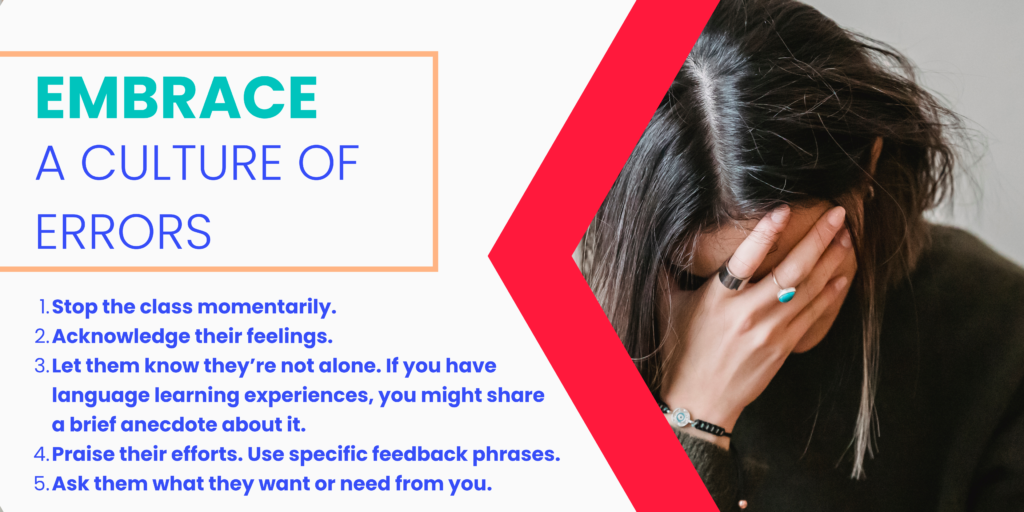
“I don’t want to make a mistake” or “I’m sorry for my bad English.”
As a language educator, these are the responses you may frequently encounter from your students. Your students may devalue themselves. They tell you they’ve been frustrated with past language learning experiences. They need help, and they’re looking to you to provide it.
You want to nurture your students’ connection to their target language. Creating a safe and inclusive environment for second language students is paramount in today’s classroom.
At Craving English, our goal is to foster a strong community of passionate language learners. We provide unwavering support to our students through kindness and empathy. Our aim is to ensure that no student leaves a class feeling disheartened or discouraged. By building strong connections with our students, we can overcome language barriers together.
So, how should you respond when faced with such situations? Let’s explore effective strategies to not only establish a safe space for your students but also to cultivate an environment where they can truly thrive.
How Does Trauma Affect Language Learning?
As educators, it’s crucial to recognize that students might struggle to express their fears, especially in a new language. Initial impressions in a new academic environment can greatly influence these learners. By approaching the classroom with empathy, teachers can account for these factors while facilitating learning.
What Types of Trauma Could Students Face in the Language Learning Classroom?
Trauma can take various forms, affecting students’ language acquisition both inside and outside the classroom. An incredible number of adults, up to 90%, report having experienced at least one traumatic event in their lives2.
Trauma can result from physical, mental, or emotional sources, often in combination. Stressors can be categorized as acute or chronic, stemming from single incidents or repeated events.
For instance:
- Acute stressors might arise from negative comments about pronunciation or ineffective communication.
- Chronic stressors could include self-imposed pressure to achieve linguistic perfection, living abroad, or fleeing conflict as a refugee.
Having too many acute or chronic stressors can negatively affect a student’s enthusiasm and commitment to their target language.
What Are the Signs of Traumatized Students in the Classroom?
Identifying signals of trauma is the first step in addressing this issue. Some common signs include:
- The student is hesitant to participate in class or avoids speaking lengthy thoughts.
- They frequently apologize for their speaking skills.
- They often forget recently learned information.
- They gradually stop attending class regularly.
These are a few examples of trauma in the classroom, but they can manifest in other manners.
How Does Unresolved Trauma Affect the Brain?
Trauma can affect several areas of your brain simultaneously. There are three important areas: the amygdala, the hippocampus, and the prefrontal cortex. All of these areas manage stress1. When trauma affects these areas, these results could occur:
- It becomes harder to distinguish between relevant and irrelevant information. Ordinary situations are more difficult to engage with.
- Your brain becomes more hyper aware. Later your emotions can diminish. For instance, you may not be as generally excited or have reduced pleasure in life.
- Even so, trauma can decrease the ability to identify the past and present. Your brain may not realize the difference between an actual traumatic event and the memory of it3.
Have you noticed this in your classroom? Knowing the signs of traumatized students is the first step. Building this environment should be a goal for all language academies, especially for trauma-affected students.
What Are Some Language Learning Myths That Prevent Learners from Improving?
Imagine you have a student who speaks their thoughts clearly and effectively. But, they simply feel like they’re not good at English. Adults language learners especially face these types of mental roadblocks. They might say or feel things like:
- I’m too old to learn a language. I should’ve learned it when I was a child.
- I don’t have the talent. I’m not good at learning another language.
- I want to get rid of my accent. How can I sound more like a native speaker?
- I feel embarrassed when I speak in another language because I’m afraid someone will make fun of me.
It’s common to feel this way. As a teacher, you should validate your students’ experiences when they mention things like these. Plus, you can also reframe their mindset.
Building your students’ confidence is key to improving their progress. When they have the confidence to speak, the more they actually speak = the more they become comfortable with the language.
Here’s the Truth Behind These Myths.
- According to the critical period hypothesis, children are able to absorb a language easier than adults because the plasticity in their brains allow them to use both hemispheres. Most adults usually only use their left hemisphere (for critical thinking)4. BUT, children are less efficient learners than adults. Children live in environments with more exposure to the language, but adults have larger vocabularies. They can already use their prior knowledge to translate and grasp the meaning of a word instantly. Adults also have deliberate learning opportunities available5.
- Talent mainly comes from dedication and passion, not something you’re born with. Some of the most famous English-first-language polyglots didn’t begin seriously learning another language until they were adults. Damon Dominique became fluent in 5+ languages after he was 18 years old. And, Ikenna D. Obi writes in his book Fluency Made Easy that he never considered himself talented at languages. Yet, he speaks over seven languages fluently after he entered university.
- Your accent is unique to your persona. What does it even mean to sound like a native speaker? Over eighty countries have English as an official language. Are you trying to sound like all eighty of those countries’ speakers? Probably not. If you encourage students to communicate their ideas more clearly, then this is a much more feasible goal.
- It’s uncomfortable to have experiences you’ve never had before. Most of our anxieties stem from fears. Even if someone did make fun of you, you don’t have to give them the power to shame you. Keep making strides towards the changes you want to see in your life. If you want to be a better speaker in your target language, then you have to keep practicing.
For more thoughts on accents and pronunciation, check out our Accents vs Pronunciation episode with Teacher Leader Olivia and Craving Philologist Ashly on Craving Podcast.
How Should You Avoid Hurting Students in the Language Classroom?
Imagine you’re a new student taking an English course in school. You enter the classroom, nervous and jittery. You have some experience with the English language. You know it’s important for your career, but you feel embarrassed when you speak it. You’re hoping to learn a lot in this class.
The teacher starts to introduce themselves and asks the other students to do the same. Then, it’s your turn. So, you say, “My name is Costa Rica. I live in Angeline.”
Oh no.
The teacher starts laughing at you hysterically.
What did I do wrong?
The embarrassment overwhelms your throat and chest. You run out of the classroom never to come back again.
This is a real experience from a Craving English student. Her traumatic experience led her not to take another English class again until she came to us this year. Now, she’s much more confident with her empathetic Craving English teacher.
This is why it’s so important to make a good first impression on students. Almost 99% of students will enter their first class extremely nervous. They will apologize for their English because they’re eager to do a good job.
Let’s take a look at what NOT to do in the classroom before revealing empowering methods of teaching.
Avoid These Things in the Classroom.
- Being disrespectful by laughing, not paying attention to a student when they’re speaking, or insulting them.
- Interrupting them constantly without acknowledging the interruption.
- Using strict and condescending language. This might sound like, “We only say it like this” or “You should know this already.”
- Using words like “wrong,” “incorrect,” or “bad” to describe the way students speak.
- Putting students on the spot rather than using elicitation skills to collect a response (e.g. “What’s the answer?” vs guiding them through context clues to come to a solution).
Avoiding these techniques lay the foundation of an empathetic and empowering class. Working in a trauma-informed academy will help you avoid these things in the classroom.
Check out twelve reasons why you should work at Craving English.
Five Trauma-Informed Strategies to Help Your Online Language Learners Today
Now that you know what to avoid, you can use these five active teaching methods in your class. Building a comfortable learning environment is the crucial step, but how exactly do you do that?
- Building rapport with your student(s). By asking personal questions, you can instantly make a student feel like you care for them. You can begin by asking about their family, job, weekend plans, hobbies, etc.
- Quickly, you’ll have deep conversations with your students because they know you value their responses. You can also build rapport by using icebreaker questions. This way you can simultaneously pull vocabulary they might not typically use on a regular basis.
- “What’s your dream vacation?”
- “What superpower would you want to have?”
- “Would you rather eat a can of worms or a can of spiders?”
- Quickly, you’ll have deep conversations with your students because they know you value their responses. You can also build rapport by using icebreaker questions. This way you can simultaneously pull vocabulary they might not typically use on a regular basis.
- Using positive body language. Smiling and nodding your head are the two most basic things you can begin with. Looking directly into the camera is like making eye contact in real life.
- More so, online teachers should avoid too much verbal confirmation. In the online space, students could perceive these verbal confirmations as interruptions since there is only one audio tunnel. As an ESL teacher, you may use total physical response (TPR) for children. With adults, it’s best to avoid using TPR.
- Pay attention to the body language of your students too. This mainly applies to students you can visibly see in the online classroom.
- Are their eyes furrowed?
- Do they seem confused?
- Do they pause often to collect their thoughts?
- Do they smile a lot?
- Are they looking at the screen?
- Are they distracted by their environment?
- Pay attention to the body language of your students too. This mainly applies to students you can visibly see in the online classroom.
- More so, online teachers should avoid too much verbal confirmation. In the online space, students could perceive these verbal confirmations as interruptions since there is only one audio tunnel. As an ESL teacher, you may use total physical response (TPR) for children. With adults, it’s best to avoid using TPR.
- Active listening. Listen to listen rather than listen to respond. In the language classroom, teachers should promote natural conversation rather than force it. Students appreciate when you listen to the details of their responses and bring up those details later on.
- At the end of class, they might tell you that they have plans to see a movie during the weekend. When you have the next class, you could ask them about the movie. There are double benefits: you showed you paid attention, and you have another opportunity to use that as an icebreaker.
- Timing is essential. Wait for natural pauses in conversation to insert extension questions. Make sure the flow of conversation is student-led rather than teacher-led. If you’re in an individual class, some students may want to spend the class doing free talk. They may want to vent about their recent struggles. Let them do that as long as it’s student-led.
- At the end of class, they might tell you that they have plans to see a movie during the weekend. When you have the next class, you could ask them about the movie. There are double benefits: you showed you paid attention, and you have another opportunity to use that as an icebreaker.
- Give specific feedback. There’s a difference between “Great job” and “I noticed your improvement in creating full sentences. Fantastic!” Make sure to acknowledge the progress your student has made. But, avoid overpraise – this can seem not authentic due to its frequency. You can use phrases like:
- Do you remember when ________ days/weeks/months/ ago when you told me _________ was difficult? Look at you now!
- I admire the way you __________.
- You’re doing so well at ___________.
- Embrace a culture of errors. Everyone makes mistakes, natives, and non-natives alike. There is no such thing as failure, only feedback. If a student has negative self-talk, it’s so important to acknowledge their bravery. Their attendance in class is a testament to their self-improvement. It’s not easy to learn another language.
- When you hear negative self-talk, here is a step-by-step guide you can use to encourage them:
- Stop the class momentarily.
- Acknowledge their feelings.
- Let them know they’re not alone. If you have language learning experiences, you might share a brief anecdote about it.
- Praise their efforts. Use any of the specific feedback phrases from above.
- Ask them what they want or need from you.
Finally, you now have a toolbox of strategies to implement in your classroom. The reason why so many students love our academy is because we have empathetic teachers. Our students think of us as friends. Learning another language should never be traumatic.

How is Craving English a Trauma-Free Space?
We believe language learning should be fun and effective. We train teachers to help students reach their full potential. Craving is a welcoming space not only for students but teachers as well. With our support, benefits, and community, you will grow immensely as a teacher.
Do You Want to Work at Craving English?
Calling all educators who create safe and empowering environments! Are you an ESL teacher who empathizes with students? Craving English is always looking for friendly and kind teachers.
Unlock the potential of trauma-informed teaching at our online English academy. Help us revolutionize language education through empathy and understanding. Together, we can shape a brighter future one lesson at a time!
If you think you’d make a great fit, get started now with our requirements about working here. Your talents could help hundreds of students here.
References

